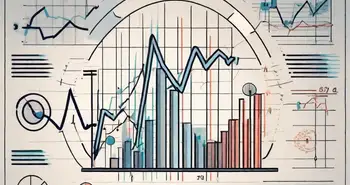The Ultimate Guide to Market Trading

Welcome to “The Ultimate Guide to Market Trading.” In this comprehensive guide, I will take you through the world of market trading, from understanding the basics to developing a successful trading strategy. So let's dive in and explore the fascinating and potentially lucrative world of market trading!
Understanding the Basics of Market Trading
Defining Market Trading
Market trading refers to the buying and selling of financial instruments, such as stocks, bonds, commodities, or currencies, with the goal of making a profit. It involves analyzing market trends, studying the performance of various assets, and making informed decisions based on your analysis.
In market trading, investors and traders participate in the financial markets, which are platforms where buyers and sellers come together to trade assets. These markets can be physical locations, such as stock exchanges, or virtual platforms, like electronic trading systems.
Market trading is not limited to a specific asset class or geographic location. It encompasses a wide range of instruments and can take place in various markets around the world. Traders can choose to focus on a specific asset class, such as stocks or commodities, or engage in multiple markets simultaneously.
The Importance of Market Trading
Market trading plays a significant role in the global economy. It provides liquidity to financial markets, allowing investors to buy and sell assets easily. This liquidity is crucial for the efficient functioning of the economy, as it ensures that capital is allocated to its most productive uses.
Furthermore, market trading enables companies to raise capital. By issuing stocks or bonds, companies can attract investors and secure funding for their operations or expansion plans. This capital injection helps businesses grow, create jobs, and contribute to economic development.
On an individual level, market trading offers opportunities for investors to grow their wealth. By carefully analyzing market trends and making informed investment decisions, individuals can potentially generate significant returns on their capital. However, it is important to note that market trading also involves risks, and investors should exercise caution and conduct thorough research before making any investment decisions.
Key Terms in Market Trading
Before jumping into the different types of market trading, it's essential to familiarize yourself with some key terms:
- Stocks: Shares of ownership in a company. When you buy stocks, you become a partial owner of the company and have the potential to benefit from its profits and growth.
- Bonds: Debt securities issued by governments or corporations. When you invest in bonds, you are essentially lending money to the issuer in exchange for regular interest payments and the return of the principal amount at maturity.
- Commodities: Raw materials, such as oil, gold, or agricultural products. Commodities are traded on specialized exchanges and are subject to supply and demand dynamics, geopolitical factors, and other market forces.
- Currencies: The exchange of one country's currency for another. Currency trading, also known as forex trading, involves buying and selling different currencies with the aim of profiting from fluctuations in exchange rates.
Understanding these key terms is essential for navigating the world of market trading. Each asset class has its unique characteristics and factors that influence its value, and being familiar with these terms will help you make informed decisions when trading in the market.
Types of Market Trading
Market trading is a dynamic and ever-evolving field that offers a variety of strategies for traders to explore. Each strategy has its own unique characteristics and requires a different set of skills and knowledge. Let's take a closer look at some of the most popular types of market trading.
Day Trading
Day trading involves opening and closing positions within the same trading day. Day traders aim to take advantage of short-term price fluctuations in the market. This strategy requires careful analysis, quick decision-making, and the ability to manage risks efficiently.
Day traders often use technical analysis tools, such as moving averages, chart patterns, and indicators, to identify potential entry and exit points. They closely monitor market news and events that can have an immediate impact on stock prices. With their nimble approach, day traders can capitalize on intraday price movements and generate profits.
Swing Trading
Swing trading is a medium-term trading strategy that aims to capture shorter-term price movements within a larger trend. Unlike day trading, swing traders typically hold positions for a few days to a few weeks. They leverage technical analysis and chart patterns to identify potential entry and exit points.
Swing traders focus on finding stocks or other financial instruments that are on the verge of making a significant move. They look for patterns such as breakouts, pullbacks, and trend reversals to determine their trading decisions. By riding the waves of price fluctuations, swing traders aim to profit from both upward and downward movements in the market.
Position Trading
Position trading is a long-term strategy where traders hold their positions for weeks, months, or even years. Position traders focus on major market trends and economic fundamentals to make informed decisions. They aim to capture the larger moves in the market and are less concerned with short-term price fluctuations.
Position traders conduct in-depth research and analysis to identify assets that have the potential for long-term growth. They consider factors such as company fundamentals, industry trends, and macroeconomic indicators. By taking a patient and long-term approach, position traders seek to maximize their profits by staying invested in positions that align with their strategic outlook.
Scalp Trading
Scalp trading involves making multiple quick trades throughout the day, aiming to profit from small price movements. Scalpers rely on technical analysis, such as chart patterns and indicators, to identify short-term trading opportunities. They capitalize on the bid-ask spread and aim to minimize their exposure to market risks.
Scalpers are highly focused and disciplined traders who closely monitor the market for short-term inefficiencies. They execute trades with precision and speed, often using advanced trading platforms and tools. Scalp trading requires a keen eye for market dynamics and the ability to make split-second decisions.
As you can see, market trading offers a wide range of strategies to suit different trading styles and preferences. Whether you prefer the fast-paced action of day trading or the patient approach of position trading, there is a strategy out there that can align with your goals and risk tolerance. It's important to remember that successful trading requires continuous learning, practice, and adaptability to changing market conditions.
Tools for Successful Market Trading
Trading Platforms
A reliable trading platform is essential for executing trades effectively. Whether you choose a web-based platform or a downloadable software, make sure it offers advanced charting tools, real-time data, and seamless order execution.
Analytical Tools
To make informed trading decisions, you need access to various analytical tools. These tools can provide valuable insights into market trends, price patterns, and indicators. Popular analytical tools include moving averages, oscillators, and Fibonacci retracements.
News and Market Data
Staying informed about the latest news and market data is crucial for successful trading. Subscribe to reliable financial news sources and use economic calendars to keep track of important events and announcements that can impact the markets.
Developing a Market Trading Strategy
Setting Your Trading Goals
Before diving into the world of market trading, it's essential to define your trading goals. Are you looking for short-term gains or long-term wealth accumulation? Understanding your objectives will help shape your trading strategy.
Risk Management in Trading
Risk management is paramount in market trading. Determine your risk tolerance and establish clear stop-loss levels to limit potential losses. Additionally, diversify your portfolio by investing in different assets to spread risk.
Building a Trading Plan
A trading plan acts as your roadmap in the market. It outlines your trading approach, risk management strategies, and entry and exit criteria. Stick to your plan and avoid making impulsive decisions based on emotions.
As an expert trader, let me share a personal story that highlights the importance of developing a sound trading strategy. Early in my trading career, I fell into the trap of chasing quick profits without proper planning. I incurred significant losses due to impulsive trades driven by emotions. However, through experience and learning from my mistakes, I developed a disciplined trading plan that has since helped me achieve consistent profits and financial stability.
FAQ
Q: What is market trading?
A: Market trading refers to the buying and selling of financial instruments, such as stocks, bonds, commodities, or currencies, with the goal of making a profit. It involves analyzing market trends, studying the performance of various assets, and making informed decisions based on your analysis.
Q: What are the different types of market trading?
A: There are several types of market trading, including day trading, swing trading, position trading, and scalp trading. Each strategy has its own timeframes, risk levels, and requirements.
Q: How can I develop a successful market trading strategy?
A: Developing a successful market trading strategy involves setting clear goals, managing risks, and building a trading plan. Define your objectives, determine your risk tolerance, and outline your approach to trading. Stick to your plan and continuously educate yourself to adapt to changing market conditions.
In conclusion, market trading offers opportunities for individuals to grow their wealth and participate in the global financial markets. Understanding the basics, exploring different trading strategies, and developing a disciplined approach are crucial for success. By implementing the tips and advice shared in this guide, you'll be well-equipped to embark on your market trading journey with confidence.

Disclaimer: All investments involve risk, and the past performance of a security, industry, sector, market, financial product, trading strategy, or individual’s trading does not guarantee future results or returns. Investors are fully responsible for any investment decisions they make. Such decisions should be based solely on an evaluation of their financial circumstances, investment objectives, risk tolerance, and liquidity needs. This post does not constitute investment advice.

Painless trading for everyone
Hundreds of markets all in one place - Apple, Bitcoin, Gold, Watches, NFTs, Sneakers and so much more.

Painless trading for everyone
Hundreds of markets all in one place - Apple, Bitcoin, Gold, Watches, NFTs, Sneakers and so much more.









